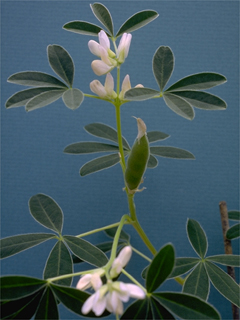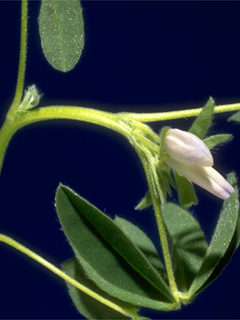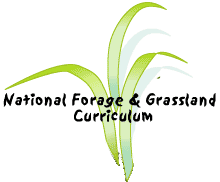- Project Information
- Instructional Design
- Instructor Materials
- Assessments
- Available Topics
- Introduction to Forages
- Overview
- Pretest - Introduction
- Instructional Objectives
- Define forages and differentiate between forage types.
- Explain how forages have been and are essential to civilization.
- Summarize the history of forages.
- Define grassland agriculture. Discuss a typical grassland ecosystem.
- Define sustainable agriculture and discuss how forages are a key component.
- List several grassland organizations and describe their role in promoting forages and grassland agriculture.
- Summary
- Exam
- References
- Grasslands of the World
- Overview
- Pretest - World Grasslands
- Instructional Objectives
- Define and describe the natural grasslands of the world.
- Locate and describe the tropical grasslands and their forages.
- Locate and describe the temperate grasslands and their forages.
- Important issues affecting grasslands and their forages.
- Summary
- Exam
- References
- Forages in the US
- Overview
- Pretest - U.S. Grasslands
- Instructional Objectives
- Describe the role of forages in the history of the US.
- Describe the current role of forages in US agriculture.
- Discuss regional forage production.
- Discuss forages from a livestock perspective.
- Discuss the environmental benefits of forages.
- Discuss the possible future role of forages in the US.
- Summary
- Exam
- References
- Grasses
- Overview
- Pretest - Grasses
- Instructional Objectives
- Grasses are very common but very important.
- Differentiate warm-season from cool-season grasses.
- Summarize the distinctive physical characteristics of grasses
- Describe the utilization of grass in forage-livestock systems.
- Describe how knowledge of grass regrowth is beneficial to forage managers.
- Provide specific information about the common grasses used as forage
- Summary
- Exam
- References
- Legumes
- Overview
- Pretest - Legumes
- Instructional Objectives
- Legumes are a valuable part of forage production.
- Differentiate warm-season from cool-season legumes.
- Summarize the distinctive physical characteristics of legumes.
- Define the utilization of legumes in forage-livestock systems.
- Provide specific information about the common legumes used as forage.
- Summary
- Exam
- References
- Plant Identification
- Overview
- Pretest - Plant Identification
- Instructional Objectives
- Explain the reasons why forage plant identification is important.
- Describe the major differences between the plant families used as forages.
- Provide the vocabulary needed to identify grasses.
- Provide the basic vocabulary for identifying legumes.
- Identify common species of forage.
- Provide practice in identifying common forages.
- Summary
- References
- Forage Selection
- Overview
- Pretest - Forage Selection
- Instructional Objectives
- The selection of a forage plant is crucial.
- Determine limitations to forage selection.
- Forage selection requires an understanding of species and cultivars.
- Discuss the advantages and disadvantages of selecting mixtures.
- A model for forage selection
- Summary
- Exam
- References
- Establishment
- Overview
- Pre-Test
- Instructional Objectives
- Discuss the advantages and disadvantages of pasture establishment
- Discuss the advantages and disadvantages of pasture renovation.
- Discuss the steps in seedbed preparation.
- Discuss the considerations of seed quality.
- Discuss the methods and timing of seeding.
- Discuss the purpose and wise utilization of companion crops.
- Summary
- Exam
- References
- Weeds
- Overview
- Pre-Test
- Define the term weed.
- Instructional Objectives
- Explain why producers and the public should be concerned about weeds.
- Describe several ways in which weeds cause forage crop and animal production losses.
- Describe methods in determining quality
- List several poisonous plants found on croplands, pasturelands, rangelands, and forests.
- Describe the five general categories of weed control methods.
- Describe the concept of Integrated Pest Management and how it applies to weed control.
- Distinguish between selective and non-selective herbicides and give an example of each.
- Describe how weeds are categorized by life cycle and how this is correlated with specific control methods.
- Describe conditions that tend to favor weed problems in pastures and describe how to alleviate these conditions.
- Describe several common weed control practices in alfalfa production.
- List printed and electronic sources of weed control information.
- List local, regional, and national sources of weed control information.
- Summary
- Exam
- References
- Management/Physiology
- Overview
- Pre-Test
- Instructional Objectives
- Discuss the basics of grass growth.
- Describe the impact of defoliation on grass plants.
- Discuss how grasses regrow.
- Discuss how livestock interaction impacts grass growth.
- Discuss grass growth in mixed stands.
- Discuss the practical applications of regrowth mechanisms.
- References
- Fertilization
- Overview
- Pre-Test
- Instructional Objectives
- Discuss the importance of soil fertility and the appropriate use of fertilization.
- Define and discuss the nitrogen cycle.
- Discuss the major elements needed for good soil fertility and plant growth.
- Define and discuss micronutrients.
- Discuss the uses and methods of liming.
- Discuss fertilizer management for mixed stands.
- References
- Biological Nitrogen Fixation
- Overview
- Pre-Test
- Instructional Objectives
- Define biological nitrogen fixation (BNF) and explain its importance.
- Describe the benefits of BNF in economic and environmental terms.
- Estimate the amount of BNF that is contributed by various crops.
- List and discuss factors that affect the quantity of nitrogen fixed.
- Describe the processes of infection and nodulation in forage legumes.
- Describe the process of inoculation in the production of forage legumes.
- Summary
- Exam
- Grazing
- Overview
- Pre-Test
- Instructional Objectives
- Discuss the role of grazing in a pasture-livestock system.
- List and discuss the types of grazing.
- Compare and contrast the different types of grazing.
- Discuss the livestock dynamics on pastures and grazing.
- Discuss the utilization of a yearly grazing calendar.
- Summary
- References
- Mechanically Harvested Forages
- Overview
- Pre-Test
- Instructional Objectives
- Discuss the purpose for mechanically harvested forages.
- List the characteristics of good hay and the steps needed to make it.
- Determine the characteristics of good silage and the steps in producing it.
- Discuss the potential dangers in mechanically harvesting and storing forages.
- Compare and contrast the types of storage and discuss the advantages and disadvantages of each.
- Summary
- References
- Irrigation
- Overview
- Pre-Test
- Instructional Objectives
- Describe the importance of irrigation in producing forages.
- Describe major types of irrigation systems in US forage production.
- List and discuss factors that affect irrigation efficiency.
- Describe basic principles of scheduling irrigation for efficient use of water resources.
- Describe potential problems that may arise from the use of irrigation in forages.
- Summary
- References
- Quality & Testing
- Overview
- Pre-Test
- Instructional Objectives
- Define forage quality and management decisions that increase forage quality.
- Describe important factors that determine hay and silage quality.
- Discuss components of forage
- Define and discuss antiquality factors affecting animal health
- Discuss the need for and progress towards standards in national forage testing
- Summary
- References
- Breeding
- Overview
- Pre-Test
- Instructional Objectives
- Discuss the history of forage breeding in the United States
- Discuss the philosophy of why new plant cultivars are needed
- Discuss the objectives of forage plant breeding
- Discuss the process of creating a new cultivar
- Discuss the steps in maintaining and producing new cultivars
- Compare and contrast plant breeding in the US and Europe
- Summary
- References
- Forage-livestock Systems
- Overview
- Pre-Test
- Define a livestock system and their importance
- Describe the basic principles of a successful forage-livestock system
- Discuss forage-livestock systems in a larger picture
- Discuss how economics are a part of a forage-livestock system
- Discuss the types of forage-livestock systems
- Summary
- References
- Miscellaneous Forages
- Overview
- Pre-Test
- Instructional Objectives
- Discuss the importance of utilizing forages other than common grasses and legumes
- Discuss the species suitable to use as miscellaneous forages
- Compare and contrast the species suitable to use as miscellaneous forages
- Discuss the utilization of crop residues in a forage-livestock system
- Discuss the utilization of a yearly grazing calendar
- Summary
- Exam
- References
- Economics of Forages
- Environmental Issues of Forages
- Overview
- Pre-Test
- Instructional Objectives
- Describe several important environmental issues that relate to forage production
- Define the terms renewable resource and nonrenewable and give examples of each resource type that are related to forage production
- Define the term sustainable agriculture and apply the concept to forage production
- Diagram and describe a sustainable forage production system
- Discuss factors that contribute to soil erosion and discuss ways that soil erosion control can be integrated into forage product
- Discuss advantages and disadvantages in using synthetic agrichemicals in forage production
- Explain the concept of Integrated Pest Management (IPM) and how it can be used to enhance sustainable forage production
- Define the term biodiversity and explain how this concept could be applied to forage production
- Discuss the controversy over using agricultural land to produce crops for animal consumption
- Summary
- References
- Introduction to Forages
- Instructor Feedback
- Laboratory Strategies
- Lecture Strategies
- Mailing Groups
- Student Materials
- Reference Materials







